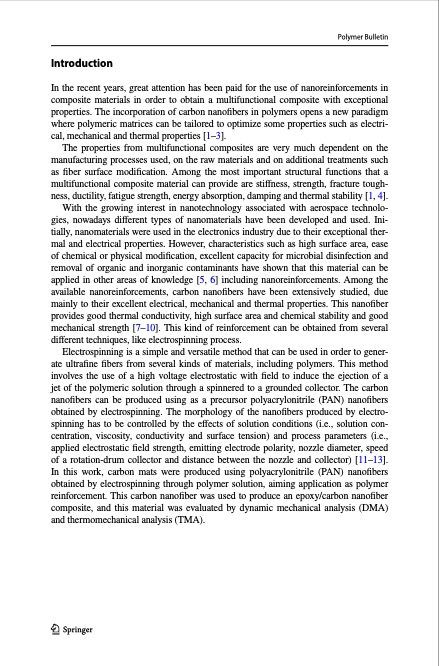
PDF Publication Title:
Text from PDF Page: 003
Introduction In the recent years, great attention has been paid for the use of nanoreinforcements in composite materials in order to obtain a multifunctional composite with exceptional properties. The incorporation of carbon nanofibers in polymers opens a new paradigm where polymeric matrices can be tailored to optimize some properties such as electri- cal, mechanical and thermal properties [1–3]. The properties from multifunctional composites are very much dependent on the manufacturing processes used, on the raw materials and on additional treatments such as fiber surface modification. Among the most important structural functions that a multifunctional composite material can provide are stiffness, strength, fracture tough- ness, ductility, fatigue strength, energy absorption, damping and thermal stability [1, 4]. With the growing interest in nanotechnology associated with aerospace technolo- gies, nowadays different types of nanomaterials have been developed and used. Ini- tially, nanomaterials were used in the electronics industry due to their exceptional ther- mal and electrical properties. However, characteristics such as high surface area, ease of chemical or physical modification, excellent capacity for microbial disinfection and removal of organic and inorganic contaminants have shown that this material can be applied in other areas of knowledge [5, 6] including nanoreinforcements. Among the available nanoreinforcements, carbon nanofibers have been extensively studied, due mainly to their excellent electrical, mechanical and thermal properties. This nanofiber provides good thermal conductivity, high surface area and chemical stability and good mechanical strength [7–10]. This kind of reinforcement can be obtained from several different techniques, like electrospinning process. Electrospinning is a simple and versatile method that can be used in order to gener- ate ultrafine fibers from several kinds of materials, including polymers. This method involves the use of a high voltage electrostatic with field to induce the ejection of a jet of the polymeric solution through a spinnered to a grounded collector. The carbon nanofibers can be produced using as a precursor polyacrylonitrile (PAN) nanofibers obtained by electrospinning. The morphology of the nanofibers produced by electro- spinning has to be controlled by the effects of solution conditions (i.e., solution con- centration, viscosity, conductivity and surface tension) and process parameters (i.e., applied electrostatic field strength, emitting electrode polarity, nozzle diameter, speed of a rotation-drum collector and distance between the nozzle and collector) [11–13]. In this work, carbon mats were produced using polyacrylonitrile (PAN) nanofibers obtained by electrospinning through polymer solution, aiming application as polymer reinforcement. This carbon nanofiber was used to produce an epoxy/carbon nanofiber composite, and this material was evaluated by dynamic mechanical analysis (DMA) and thermomechanical analysis (TMA). 13 Polymer BulletinPDF Image | Carbon nanofibers obtained from electrospinning process

PDF Search Title:
Carbon nanofibers obtained from electrospinning processOriginal File Name Searched:
Artigoelectrospinnigprocess2019.pdfDIY PDF Search: Google It | Yahoo | Bing
Sulfur Deposition on Carbon Nanofibers using Supercritical CO2 Sulfur Deposition on Carbon Nanofibers using Supercritical CO2. Gamma sulfur also known as mother of pearl sulfur and nacreous sulfur... More Info
CO2 Organic Rankine Cycle Experimenter Platform The supercritical CO2 phase change system is both a heat pump and organic rankine cycle which can be used for those purposes and as a supercritical extractor for advanced subcritical and supercritical extraction technology. Uses include producing nanoparticles, precious metal CO2 extraction, lithium battery recycling, and other applications... More Info
| CONTACT TEL: 608-238-6001 Email: greg@infinityturbine.com | RSS | AMP |